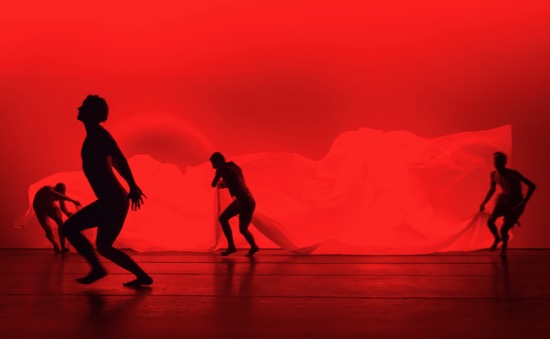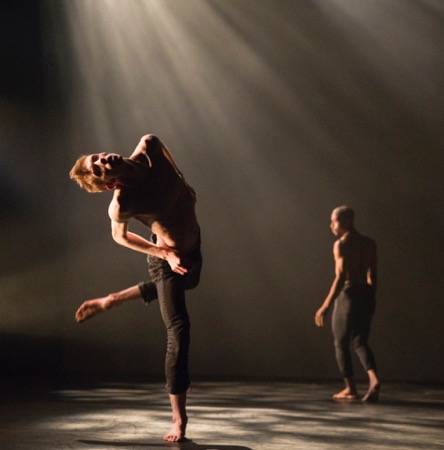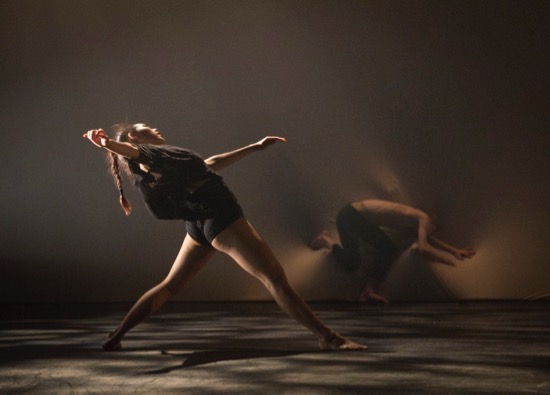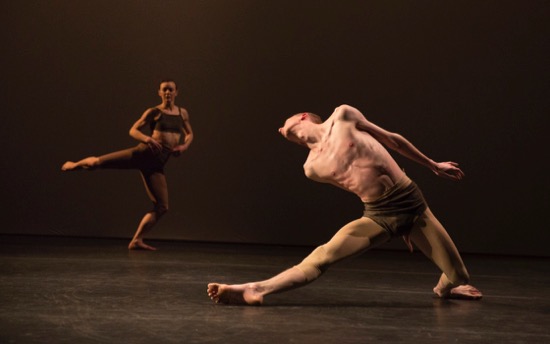
Who are these people, these inhabitants of Andrea Miller’s To Create a World? They are, of course, members of her company Gallim and collaborators in the work’s choreography, but that doesn’t answer the question. They seem to be part of an evolving world of fire and ice, themselves perhaps evolving. In Will Epstein’s score for piano, electronics, voice, percussion, synthesizers, saxophone, plus violin and guitar, you may hear ominous rumblings, scrapings, gurgling, crashes, outcries, hesitant melodies, ringing sounds, and what could be galloping hooves. Burke Brown’s lighting turns the Joyce Theater’s stage completely red, cools it down, shadows it at the back, pierces it with beams, softens it with smoke. Welcome to a primordial world that’s fiercer than anything religious texts ordain.
While we spectators are being ushered to our seats and consulting our programs, something is already developing on the stage. Behind the white spandex curtain stretched across the front of it, something presses against it, revealing the outlines of a human forearm, a calf, maybe a brow (sometimes these slight protuberances are more complex). They appear, disappear, move to different locations. Just before the house lights go out, a naked body slides partway out from underneath the fabric wall. It’s only much later that I remember the stage in a pregnancy when the faint imprint of infant’s foot occasionally pushes out the skin of its carrier’s belly.
I wish that I’d been able to see a work that Miller presented last year in three separate, bare-walled galleries of the Met Breuer. Sometimes in To Create a World, the seven dancers (Ashley Hill, Allysen Hooks, David Maurice, Gary Reagan, Haley Sung, Isabel Umali, and Dan Walczak) are isolated, either not noticing one another or seeming thrown together by accident.

In the beginning, once the white curtain has lifted, they’re flying around in dim light, appearing to be half naked. Everyone is on her/his own. You wonder that they don’t collide. Suddenly they’re gone, leaving only Reagan sprawled on the floor face down and Hooks squatting some distance away, then balancing on her butt, legs and body angled up. Reagan collects himself laboriously. Tall, skinny, and extremely flexible (that he studied the technique known as “gaga” in Israel is obvious), he travels across the space like an inchworm. Once on his feet, he takes riskily big steps, lifting each leg high, and—a shock!—stumbles over Hooks and falls on top of her. The two of them are awkwardly nuzzling each other when the remaining five dancers enter, pressed together to form a different sort of caterpillar; separating, regrouping, eventually they creep away.
As Miller’s mysterious creatures (costumed by Jose Solis) come and go, they behave as if they’re inventing behavior. A woman (Umali, as I remember, walks her feet up Walczak’s leg. Maurice lies on his back, and Hooks sits on his raised feet, balancing herself by grasping his lifted hand. Hill and Hooks lean together, braced. Hooks, kneeling, picks up one foot behind her as if she’s never seen it before and then lets it fall and hit the floor. And sometimes it’s difficult to know whether they’re helping or challenging one another. Alarmingly, a group grabs Sung’s arms or legs, twists her, and then races around dragging her along the floor. Images such as these seem to seethe out of nowhere and as quickly dissolve.

The title To Create a World gives me pause. Maybe these people are creating a world, but it also seems as if they’re coping with a drastically changing one—fiery one moment, chilly the next. Or perhaps there are two worlds, bloodied and purified. Three of them rush on carrying a plastic sheet the width of the stage. Once it’s been dropped, two of them thrash beneath it, causing it to foam up like surf; when those onstage crawl away, I thinking of waves ebbing.
I also, at times, think of newborn mammals blindly striving to find a teat to suck on. A dancer may thrust her head against someone else in an awkward, experimental way—slipping under an arm, pushing against a shoulder or a belly. However, stuck in a world whose climate changes more and more often, its inhabitants often do deploy their bodies efficiently—team up, strut in fierce unison, run in place, jump strenuously and repeatedly. Certain moves recur; for example, a performer plants his/her feet wide apart, knees bent, and swings one arm in a circle, as if hurling something. Awkwardness and tentativeness redesigned become virtuosic, as controlled as the tiny tiptoe steps that sometimes carry the dancers along a path.

Midway through the piece, Reagan, alone onstage, ventures on a solo. Now he’s wearing a pair of full-cut shorts made of a gleaming red fabric. What is he trying to do? He arches himself into a backbend, bracing himself not on his hands, but on his forearms. He walks with his legs spraddled, sinks to the floor in a split, then wrenches himself upward into a standing position. His joints seem made of something more malleable than bones in sockets. The lights redden again after this.
Suddenly the elasticized backdrop absorbs Reagan from behind, invisible hands lifting him; this is just a hint of what awaits him a bit later. As the remaining, stupendously heroic dancers cluster, he and Hooks embrace. Then—a shock—he drops off the edge of the stage into the aisle, and climbs quickly back onto it. The others reprise the individualized running and leaping and dodging they had done at the beginning of To Create a World. But that’s not how Miller’s fascinating, thought-provoking work finishes. The last thing we see is Reagan and Hooks alone together upstage and slightly off the floor, curled up in a white fabric nest that’s held there by those unseen hands. Perhaps they are waiting to be re-born elsewhere.

Your description is dazzling!
The gorgeousness the writing and willingness and courage to take a look beneath the skin of the choreography and the generosity of spirit is pure Deborah. We need more of you!!!!!!!
Thank you for the great review.
How much nudity is visible? From the description perhaps it may have been better unseen?
Thank you for your response, Kim. However, there was no nudity on view. I think you misinterpreted my words.